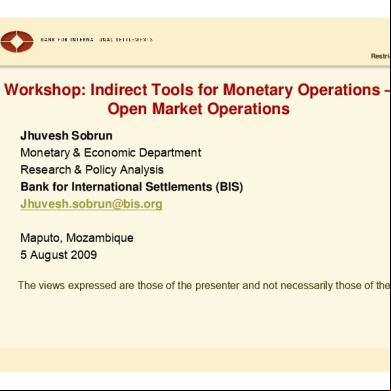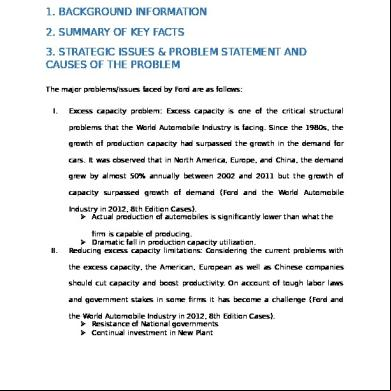Monetary Policy Of India 4o2b5g
This document was ed by and they confirmed that they have the permission to share it. If you are author or own the copyright of this book, please report to us by using this report form. Report 3i3n4
Overview 26281t
& View Monetary Policy Of India as PDF for free.
More details 6y5l6z
- Words: 899
- Pages: 22
Group
•Sarmistha
Sahoo •Babaji Prusty •Kaberi Majhi
What is Monetary Policy? Monetary
policy is the policy by which the monetary authority of the country controls the supply of money.
Monetary
policy refers to the use of instruments under the control of the RBI to regulate the availability cost and use of money and credit.
Types of Monetary Policy
Objectives of Monetary Policy:Rapid growth of economics Price stability Exchange rate stability Full employment/Increased employment Equal income distribution Balance of Payment(BOP) equilibrium
Monetary Policy of India The Reserve Bank of India(RBI) is the central banking system of India and controls the monetary policy of rupee. This institution was established on 1 April 1935 and plays an important role in the development strategy of Government.
Making of Monetary Policy
Monetary Policy is communicated to the public mostly by annual policy statement in April and mid-term review on October. The statements today are more analytical and elaborate & RBI website is an effective medium of communication. Governor, Deputy Governors, committee of board meet every week to review the monetary, economic and financial conditions. Periodic consultations and Ministry of Finance for significant technical, analytical, institutional and dynamic inputs.
Governor of RBI 1935-1937
Sir Osborne Smith 1st Governor of RBI
2 0 1 3 - Present
Raghuram Rajan Present Governor of RBI
Role of RBI 1. 2. 3.
4.
5. 6. 7.
Issue of Bank notes Banker to Government Custodian of Cash Reserves of Commercial Banks Custodian of Country’s Foreign Currency Reserves Lender to Last Resort Central Clearance and s Settlement Controller of Credit
Major Operation of Monetary Policy Cash
Reserve Ratio:-
Cash Reserve Ratio is a certain percentage of bank deposits which banks are required to keep with RBI in the form of reserves or balances. Statutory
Liquidity Ratio:-
The minimum percentage of deposit that the bank has to maintain in the form of gold, cash or other approved securities are known as Statutory Reserve Ratio.
Bank
Rate:-
The rate at which RBI lends money to domestic banking system. The Bank Rate is also known as Discount Rate. This banking system involves commercial banks, co-operative banks, IFC, EXIM Bank and other approved financial institution. Call
Money Rate:-
The rate at which commercial bank borrows money from other commercial banks for a short period.
Prime Lending Rate:The rate at which the commercial bank can provide credit to industries or business.
Deposit Rate:The rate of interest at which the customers are paid interest on their bank deposits.
Bond Rate:To meet expenses for the development, Government issues the bond maturing in definite period at a definite rate.
Repo
and Reserve Rate:The interest rate at which RBI provides loan to commercial banks is known as REPO RATE. The rate at which RBI takes short term credit is known as RESERVE REPO RATE.
Operations
Current RBI Rates:-
Rate
Bank Rate
9%
CRR
4%
SLR
22%
Repo Rate
8%
Reserve Repo Rate
7%
Inflation
8%
Marginal Standing Facility Rate
9%
Impact of Monetary Policy on Indian Economy
Economy:-
The state of a country or region in of the production and consumption of goods and services and the supply of money.
Money
Supply:-
The total stock of money circulating in an economy is the money supply. The circulating money involves the currency, printed notes, money in the deposit s and in the form of other liquid assets.
Inflation:-
Inflation occurs due to an imbalance between demand and supply of money, changes in production and distribution cost or increase in taxes on products. When economy experiences inflation, i.e. when the price level of goods and services rises, the value of currency reduces. Formula for calculating Inflation= (WPI in month of current year-WPI in same month of previous year) ---------------------------------------------------------------- X 100 WPI in same month of previous year
Lending
Rate:-
Lending Rate is the rate at which financial institutes lend money. It constitutes the base from which banks then lend money to the final customer. Interest
rate:-
An interest rate is the rate at which interest is paid by a borrower (debtor) for the use of money that they borrow from a lender(creditor). Specifically, the interest rate (I/m) is a percentage of principal (P) paid a certain number of times (m) per period (usually quoted per year).
'GROSS
DOMESTIC PRODUCT - GDP' The monetary value of all the finished goods and services produced within a country's borders in a specific time period, though GDP is usually calculated on an annual basis. It includes all of private and public consumption, government outlays, investments and exports less imports that occur within a defined territory.
GDP = C + G + I + NX
where: "C" is equal to all private consumption, or consumer spending, in a nation's economy "G" is the sum of government spending "I" is the sum of all the country's businesses spending on capital "NX" is the nation's total net exports, calculated as total exports minus total imports. (NX = Exports - Imports)
Limitation:
Restricted Scope of Monetary Policy in Economic Development. Limited Role in Controlling Prices. Unfavourable Banking Habits. Underdeveloped Money Market. Existence of Black Money. Conflicting Objectives Influence of Non-Monetary Factors Limitations of Monetary Instruments Proper Implementation of the Monetary Policy:
Thank You
•Sarmistha
Sahoo •Babaji Prusty •Kaberi Majhi
What is Monetary Policy? Monetary
policy is the policy by which the monetary authority of the country controls the supply of money.
Monetary
policy refers to the use of instruments under the control of the RBI to regulate the availability cost and use of money and credit.
Types of Monetary Policy
Objectives of Monetary Policy:Rapid growth of economics Price stability Exchange rate stability Full employment/Increased employment Equal income distribution Balance of Payment(BOP) equilibrium
Monetary Policy of India The Reserve Bank of India(RBI) is the central banking system of India and controls the monetary policy of rupee. This institution was established on 1 April 1935 and plays an important role in the development strategy of Government.
Making of Monetary Policy
Monetary Policy is communicated to the public mostly by annual policy statement in April and mid-term review on October. The statements today are more analytical and elaborate & RBI website is an effective medium of communication. Governor, Deputy Governors, committee of board meet every week to review the monetary, economic and financial conditions. Periodic consultations and Ministry of Finance for significant technical, analytical, institutional and dynamic inputs.
Governor of RBI 1935-1937
Sir Osborne Smith 1st Governor of RBI
2 0 1 3 - Present
Raghuram Rajan Present Governor of RBI
Role of RBI 1. 2. 3.
4.
5. 6. 7.
Issue of Bank notes Banker to Government Custodian of Cash Reserves of Commercial Banks Custodian of Country’s Foreign Currency Reserves Lender to Last Resort Central Clearance and s Settlement Controller of Credit
Major Operation of Monetary Policy Cash
Reserve Ratio:-
Cash Reserve Ratio is a certain percentage of bank deposits which banks are required to keep with RBI in the form of reserves or balances. Statutory
Liquidity Ratio:-
The minimum percentage of deposit that the bank has to maintain in the form of gold, cash or other approved securities are known as Statutory Reserve Ratio.
Bank
Rate:-
The rate at which RBI lends money to domestic banking system. The Bank Rate is also known as Discount Rate. This banking system involves commercial banks, co-operative banks, IFC, EXIM Bank and other approved financial institution. Call
Money Rate:-
The rate at which commercial bank borrows money from other commercial banks for a short period.
Prime Lending Rate:The rate at which the commercial bank can provide credit to industries or business.
Deposit Rate:The rate of interest at which the customers are paid interest on their bank deposits.
Bond Rate:To meet expenses for the development, Government issues the bond maturing in definite period at a definite rate.
Repo
and Reserve Rate:The interest rate at which RBI provides loan to commercial banks is known as REPO RATE. The rate at which RBI takes short term credit is known as RESERVE REPO RATE.
Operations
Current RBI Rates:-
Rate
Bank Rate
9%
CRR
4%
SLR
22%
Repo Rate
8%
Reserve Repo Rate
7%
Inflation
8%
Marginal Standing Facility Rate
9%
Impact of Monetary Policy on Indian Economy
Economy:-
The state of a country or region in of the production and consumption of goods and services and the supply of money.
Money
Supply:-
The total stock of money circulating in an economy is the money supply. The circulating money involves the currency, printed notes, money in the deposit s and in the form of other liquid assets.
Inflation:-
Inflation occurs due to an imbalance between demand and supply of money, changes in production and distribution cost or increase in taxes on products. When economy experiences inflation, i.e. when the price level of goods and services rises, the value of currency reduces. Formula for calculating Inflation= (WPI in month of current year-WPI in same month of previous year) ---------------------------------------------------------------- X 100 WPI in same month of previous year
Lending
Rate:-
Lending Rate is the rate at which financial institutes lend money. It constitutes the base from which banks then lend money to the final customer. Interest
rate:-
An interest rate is the rate at which interest is paid by a borrower (debtor) for the use of money that they borrow from a lender(creditor). Specifically, the interest rate (I/m) is a percentage of principal (P) paid a certain number of times (m) per period (usually quoted per year).
'GROSS
DOMESTIC PRODUCT - GDP' The monetary value of all the finished goods and services produced within a country's borders in a specific time period, though GDP is usually calculated on an annual basis. It includes all of private and public consumption, government outlays, investments and exports less imports that occur within a defined territory.
GDP = C + G + I + NX
where: "C" is equal to all private consumption, or consumer spending, in a nation's economy "G" is the sum of government spending "I" is the sum of all the country's businesses spending on capital "NX" is the nation's total net exports, calculated as total exports minus total imports. (NX = Exports - Imports)
Limitation:
Restricted Scope of Monetary Policy in Economic Development. Limited Role in Controlling Prices. Unfavourable Banking Habits. Underdeveloped Money Market. Existence of Black Money. Conflicting Objectives Influence of Non-Monetary Factors Limitations of Monetary Instruments Proper Implementation of the Monetary Policy:
Thank You










